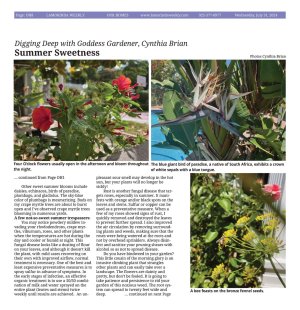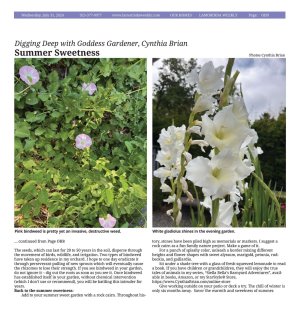|
|
Published July 31st, 2024
|
Digging Deep with Goddess Gardener, Cynthia Brian
|
| Summer Sweetness
|
| By Cynthia Brian |
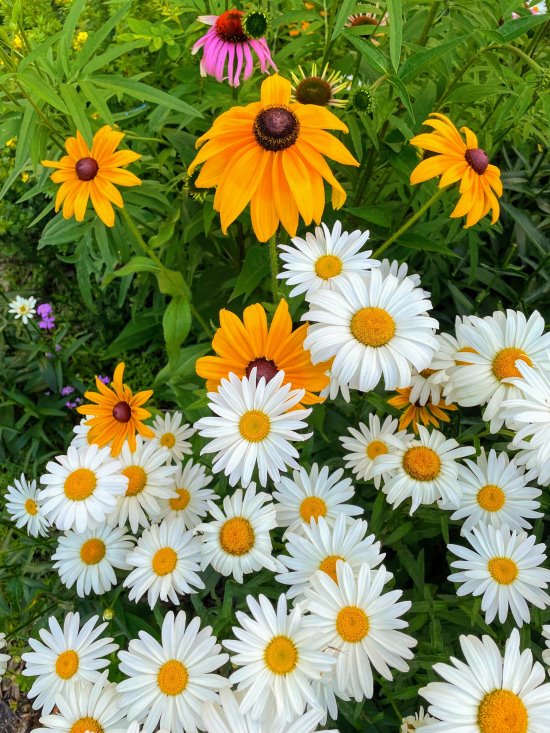 |
| Daisies, rudbeckia, and echinacea enrich the sweetness of summer. Photo Cynthia Brian |
"What good is the warmth of summer, without the cold of winter to give it sweetness." John Steinbeck
 It is still hot, yet a cool breeze wafts through the patio where I am writing under an awning. I can't bear being inside an office when I can do my work outside on my trusty Mac laptop with a full view of nature, the soothing sounds of a gurgling fountain, and the perfumed air from my roses and viburnum. In the cold of winter, I long for days like these: warm, sunny, and sweet.
It is still hot, yet a cool breeze wafts through the patio where I am writing under an awning. I can't bear being inside an office when I can do my work outside on my trusty Mac laptop with a full view of nature, the soothing sounds of a gurgling fountain, and the perfumed air from my roses and viburnum. In the cold of winter, I long for days like these: warm, sunny, and sweet.
 Hummingbirds, bees, and butterflies are darting about, oblivious to my presence. The fiery orange crocosmia, also known as coppertips or firecracker plant, is on display and attracting pollinators. I adore this exotic perennial because the corms are easily transplantable, it blooms when so many other plants are dormant, and it is showy in floral arrangements. Although it is a sun lover, I've also planted it in sheltered shade for longer-lasting blooms.
Hummingbirds, bees, and butterflies are darting about, oblivious to my presence. The fiery orange crocosmia, also known as coppertips or firecracker plant, is on display and attracting pollinators. I adore this exotic perennial because the corms are easily transplantable, it blooms when so many other plants are dormant, and it is showy in floral arrangements. Although it is a sun lover, I've also planted it in sheltered shade for longer-lasting blooms.
 Bees are gathered on my bronze fennel. I cut a few fronds of seeds to sprinkle on my vegetables for tonight's meal without bothering the buzzers. Walking my property, I noticed that my many hollyhocks were being eaten by the painted lady butterfly caterpillars. Painted lady butterflies are found throughout the world and because they are such beneficial and beautiful pollinators, I am happy that they dine on my hollyhocks.
Bees are gathered on my bronze fennel. I cut a few fronds of seeds to sprinkle on my vegetables for tonight's meal without bothering the buzzers. Walking my property, I noticed that my many hollyhocks were being eaten by the painted lady butterfly caterpillars. Painted lady butterflies are found throughout the world and because they are such beneficial and beautiful pollinators, I am happy that they dine on my hollyhocks.
 My fragrant four o'clock plants didn't get the memo that they were supposed to bloom in the late afternoon or early evening. My flowers bloom like clockwork every morning from nine to 11. Many years ago, my mom gave me seeds from her species growing on our ranch. They have perennially sprouted and supported a multitude of pollinators, including the nocturnal moths. As a kid, I remember that her four o'clocks bloomed on time in the late afternoon.
My fragrant four o'clock plants didn't get the memo that they were supposed to bloom in the late afternoon or early evening. My flowers bloom like clockwork every morning from nine to 11. Many years ago, my mom gave me seeds from her species growing on our ranch. They have perennially sprouted and supported a multitude of pollinators, including the nocturnal moths. As a kid, I remember that her four o'clocks bloomed on time in the late afternoon.
 Other sweet summer blooms include daisies, echinacea, birds of paradise, plumbago, and gladiolus. The sky-blue color of plumbago is mesmerizing. Buds on my crape myrtle trees are about to burst open and I've observed crape myrtle trees blooming in numerous yards.
Other sweet summer blooms include daisies, echinacea, birds of paradise, plumbago, and gladiolus. The sky-blue color of plumbago is mesmerizing. Buds on my crape myrtle trees are about to burst open and I've observed crape myrtle trees blooming in numerous yards.
 A few not-so-sweet summer trespassers:
A few not-so-sweet summer trespassers:
 You may notice powdery mildew invading your rhododendrons, crape myrtles, viburnum, roses, and other plants when the temperatures are hot during the day and cooler or humid at night. This fungal disease looks like a dusting of flour on your leaves, and although it doesn't kill the plant, with mild cases recovering on their own with improved airflow, normal treatment is necessary. One of the best and least expensive preventative measures is to spray sulfur in advance of symptoms. In the early stages of infection, an effective organic treatment is to use a 50/50 combination of milk and water sprayed on the entire plant (leaves and stems) twice weekly until results are achieved. An unpleasant sour smell may develop in the hot sun, but your plants will no longer be sickly!
You may notice powdery mildew invading your rhododendrons, crape myrtles, viburnum, roses, and other plants when the temperatures are hot during the day and cooler or humid at night. This fungal disease looks like a dusting of flour on your leaves, and although it doesn't kill the plant, with mild cases recovering on their own with improved airflow, normal treatment is necessary. One of the best and least expensive preventative measures is to spray sulfur in advance of symptoms. In the early stages of infection, an effective organic treatment is to use a 50/50 combination of milk and water sprayed on the entire plant (leaves and stems) twice weekly until results are achieved. An unpleasant sour smell may develop in the hot sun, but your plants will no longer be sickly!
 Rust is another fungal disease that targets roses, especially in summer. It manifests with orange and/or black spots on the leaves and stems. Sulfur or copper can be used as a preventative measure. When a few of my roses showed signs of rust, I quickly removed and destroyed the leaves to prevent further spread. I also improved the air circulation by removing surrounding plants and weeds, making sure that the roses were being watered at the roots and not by overhead sprinklers. Always disinfect and sanitize your pruning shears with alcohol so as not to spread disease.
Rust is another fungal disease that targets roses, especially in summer. It manifests with orange and/or black spots on the leaves and stems. Sulfur or copper can be used as a preventative measure. When a few of my roses showed signs of rust, I quickly removed and destroyed the leaves to prevent further spread. I also improved the air circulation by removing surrounding plants and weeds, making sure that the roses were being watered at the roots and not by overhead sprinklers. Always disinfect and sanitize your pruning shears with alcohol so as not to spread disease.
 Do you have bindweed in your garden? This little cousin of the morning glory is an invasive climbing plant that strangles other plants and can easily take over a landscape. The flowers are dainty and pretty, but don't be fooled. It is going to take patience and persistence to rid your garden of this noxious weed. The root system can spread to twenty feet wide and deep. The seeds, which can last for 20 to 50 years in the soil, disperse through the movement of birds, wildlife, and irrigation. Two types of bindweed have taken up residence in my orchard. I hope to one day eradicate it through perseverant pulling of new sprouts which will eventually cause the rhizomes to lose their strength. If you see bindweed in your garden, do not ignore it - dig out the roots as soon as you see it. Once bindweed has established itself in your garden, without chemical intervention (which I don't use or recommend), you will be battling this intruder for years.
Do you have bindweed in your garden? This little cousin of the morning glory is an invasive climbing plant that strangles other plants and can easily take over a landscape. The flowers are dainty and pretty, but don't be fooled. It is going to take patience and persistence to rid your garden of this noxious weed. The root system can spread to twenty feet wide and deep. The seeds, which can last for 20 to 50 years in the soil, disperse through the movement of birds, wildlife, and irrigation. Two types of bindweed have taken up residence in my orchard. I hope to one day eradicate it through perseverant pulling of new sprouts which will eventually cause the rhizomes to lose their strength. If you see bindweed in your garden, do not ignore it - dig out the roots as soon as you see it. Once bindweed has established itself in your garden, without chemical intervention (which I don't use or recommend), you will be battling this intruder for years.
 Back to the summer sweetness:
Back to the summer sweetness:
 Add to your summer sweet garden with a rock cairn. Throughout history, stones have been piled high as memorials or markers. I suggest a rock cairn as a fun family nature project. Make a game of it.
Add to your summer sweet garden with a rock cairn. Throughout history, stones have been piled high as memorials or markers. I suggest a rock cairn as a fun family nature project. Make a game of it.
 For a punch of splashy color, unleash a border mixing different heights and flower shapes with sweet alyssum, marigold, petunia, rudbeckia, and gaillardia.
For a punch of splashy color, unleash a border mixing different heights and flower shapes with sweet alyssum, marigold, petunia, rudbeckia, and gaillardia.
 Sit under a shade tree with a glass of fresh-squeezed lemonade to read a book. If you have children or grandchildren, they will enjoy the true tales of animals in my series, "Stella Bella's Barnyard Adventures", available in books, Amazon, or my StarStyler Store,
https://www.CynthiaBrian.com/online-store
Sit under a shade tree with a glass of fresh-squeezed lemonade to read a book. If you have children or grandchildren, they will enjoy the true tales of animals in my series, "Stella Bella's Barnyard Adventures", available in books, Amazon, or my StarStyler Store,
https://www.CynthiaBrian.com/online-store
 Give working outside on your patio or deck a try. The chill of winter is only six months away. Savor the warmth and sweetness of summer.
Give working outside on your patio or deck a try. The chill of winter is only six months away. Savor the warmth and sweetness of summer. |
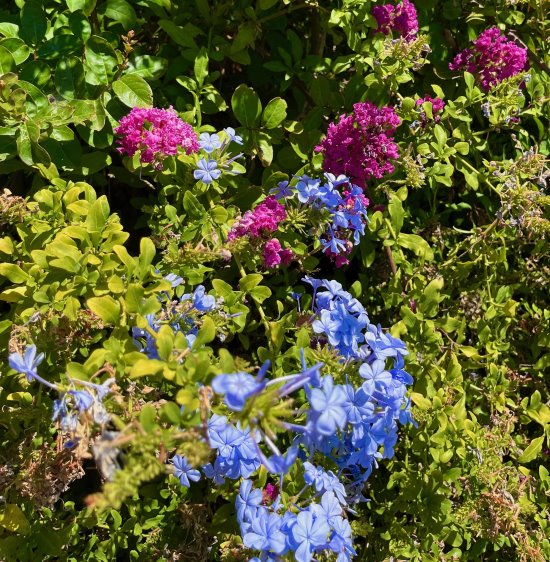 |
| Sky blue plumbago with pink crape myrtle. Photo Cynthia Brian |
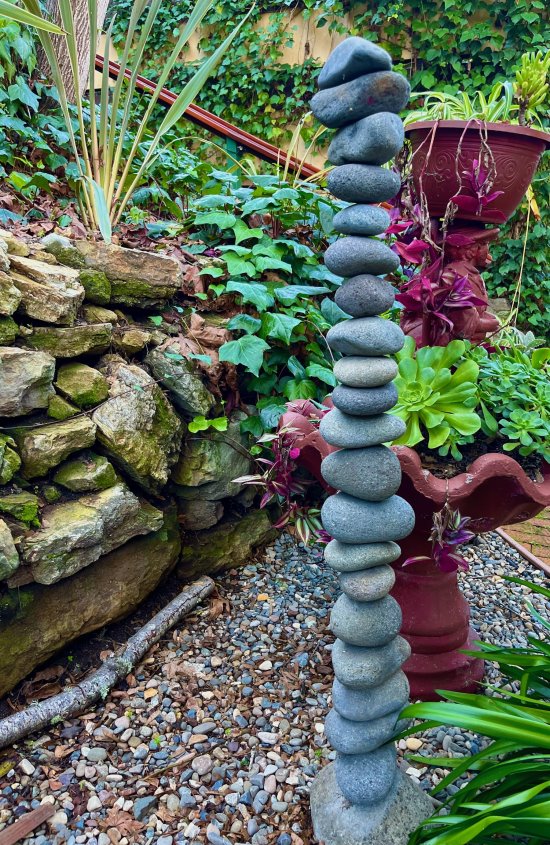 |
| Build a rock cairn for fun or as a monument. Photo Cynthia Brian |
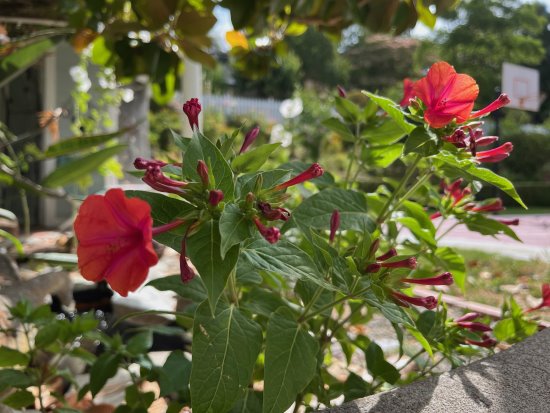 |
| Four O'clock flowers usually open in the afternoon and bloom throughout the night. Photo Cynthia Brian |
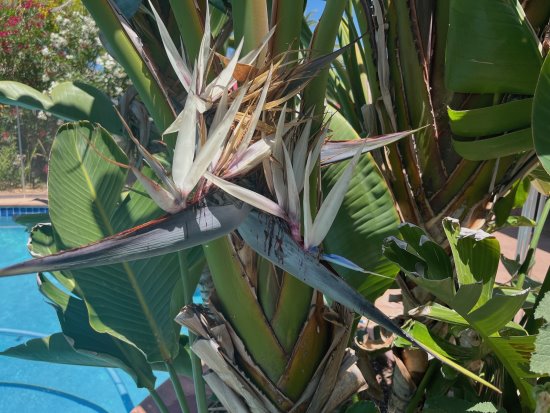 |
| The blue giant bird of paradise, a native of South Africa, exhibits a crown of white sepals with a blue tongue. Photo Cynthia Brian |
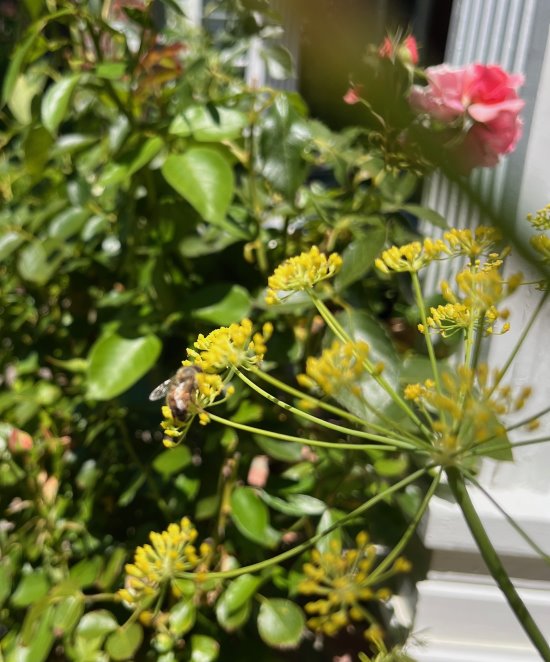 |
| A bee feasts on the bronze fennel seeds. |
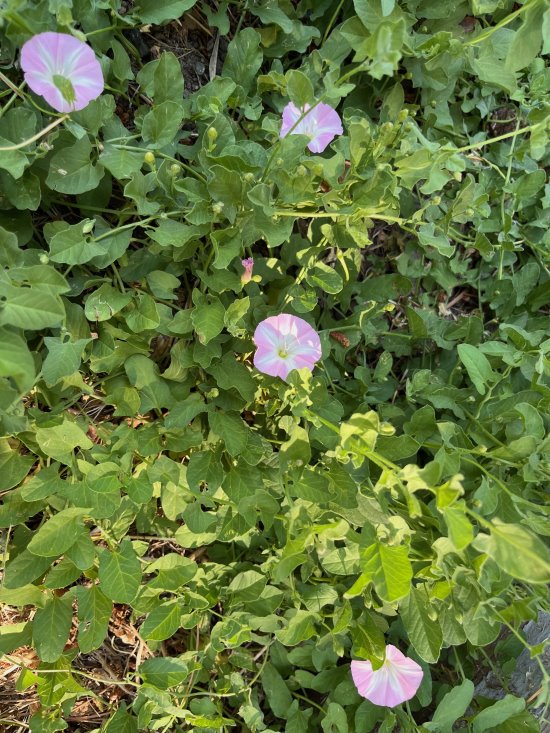 |
| Pink bindweed is pretty yet an invasive, destructive weed. |
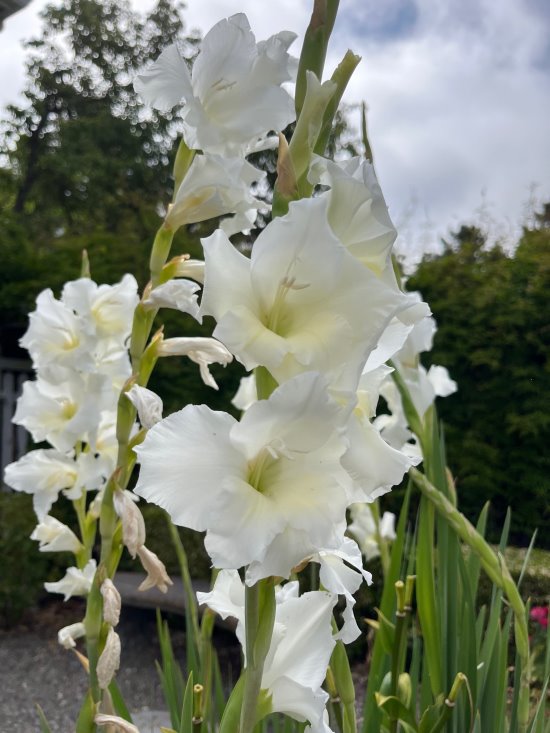 |
| White gladiolus shines in the evening garden. |
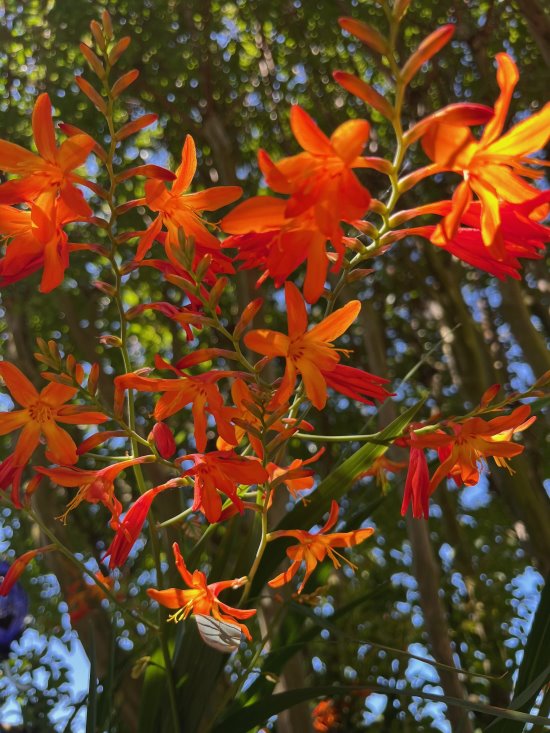 |
| Fiery firecracker, crocosmia is a pollinator magnet. |
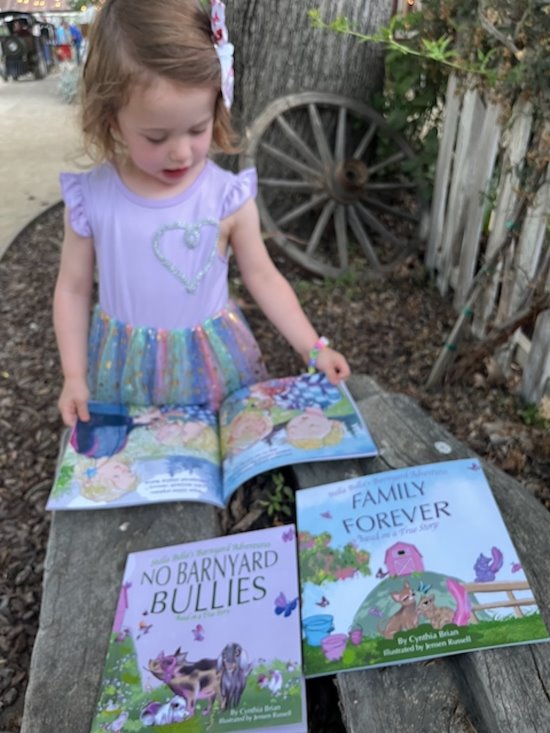 |
| The book series, "Stella Bella's Barnyard Adventures" by Cynthia
Brian enthralls toddlers. |
 |
| Cynthia Brian prefers the outdoors near the gurgling fountain. For more gardening advice for all seasons, check out Growing with the Goddess Gardener at
https://www.CynthiaBrian.com/books. Raised in the vineyards of Napa County, Cynthia Brian is a New York Times best-selling author, actor, radio personality, speaker, media and writing coach as well as the Founder and Executive Director of Be the Star You Are!r 501 c3 which was just honored as the 2024 Nonprofit of the Year by the Moraga Chamber of Commerce. Tune into Cynthia's StarStyler Radio Broadcast at
www.StarStyleRadio.com. Her newest children's picture book, Books in the Barnyard: Oh Deer!, from the series, Stella Bella's Barnyard Adventures is available for discounted pre-sales at
https://www.CynthiaBrian.com/online-store. Hire Cynthia for writing projects, garden consults, and inspirational lectures.
Cynthia@GoddessGardener.com |
|
|
|













